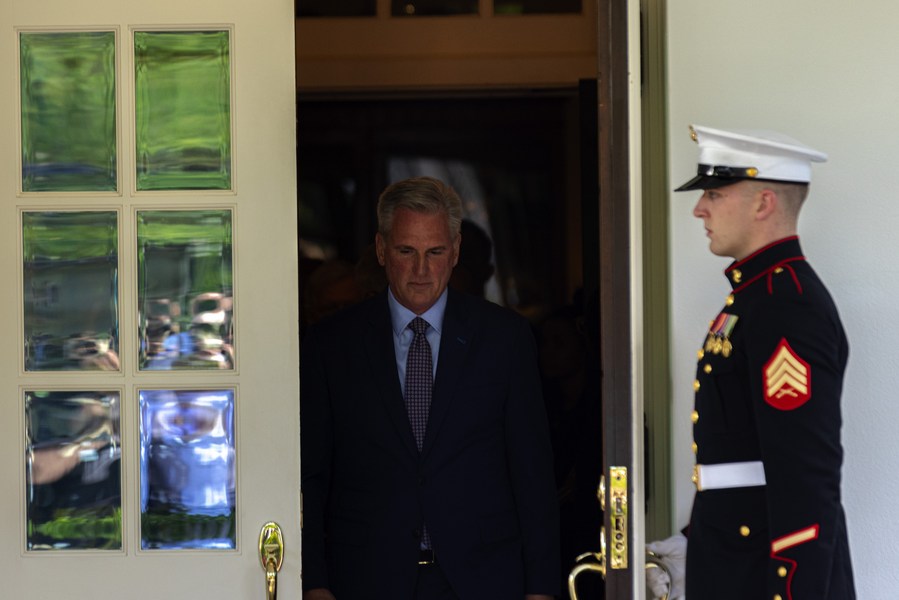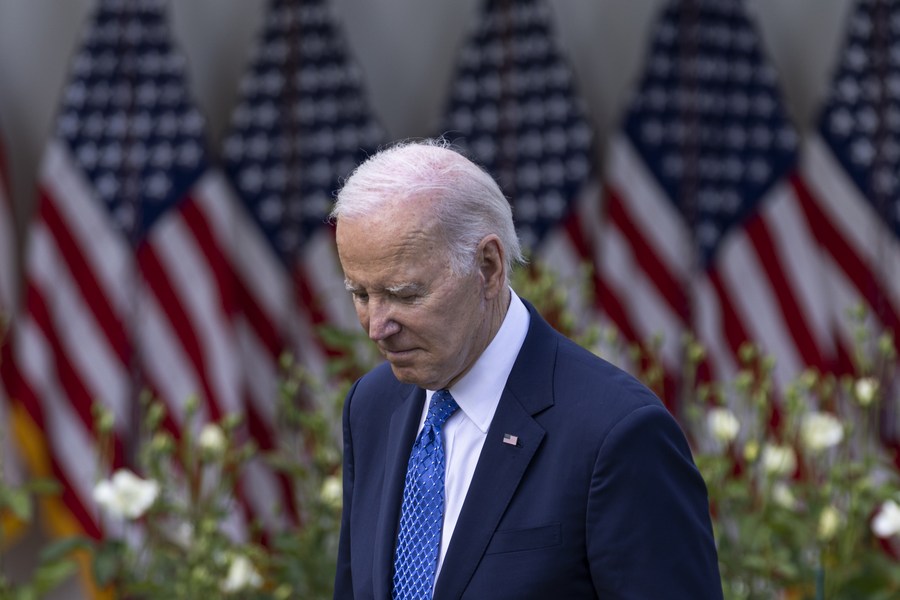
Republican House Speaker Kevin McCarthy speaks to the press after a high-profile debt ceiling meeting in Washington, D.C., the United States, May 9, 2023. (Photo by Aaron Schwartz/Xinhua)
Answers to the following four questions may provide some insight for other countries around the world into how to avoid falling victim to the spillover effects of the U.S. debt crisis.
BEIJING, June 2 (Xinhua) -- The U.S. Congress's passage of the debt ceiling bill late Thursday, just days before a looming default deadline, might have come as a respite for global investors.
But as the two parties of the United States routinely engage in political showdowns over the debt ceiling, the periodic U.S. debt crisis has become a "gray rhino" threatening global economic and financial security.
Answers to the following four questions may provide some insight for other countries around the world into how to avoid falling victim to the spillover effects of the U.S. debt crisis.
Q1: Why does America repeatedly raise the debt ceiling?
The U.S. government has modified its debt ceiling 103 times since 1945. Federal debt has soared from 3.2 trillion U.S. dollars in 1990 to over 31.4 trillion this year, accounting for more than 120 percent of its annual gross domestic product (GDP), according to the U.S. Treasury Department.
The debt ceiling, or the U.S. Treasury Department's "credit limit," is the maximum amount of debt set by the U.S. Congress for the federal government to fulfill payment obligations.
When created in 1917, the debt ceiling was designed to keep a regular check on government spending and control debt growth, but in recent years, it has become more of a routine topic in partisan fights between Democrats and Republicans.
With the partisan divide widening in recent years, a debt ceiling drama has repeatedly been staged in Washington.
Lawmakers from different parties use last-minute negotiations to push for more political gains, but neither side is concerned with the consequence of rampant borrowing.
Normally, after months of playing a game of chicken, they would eventually come to an agreement on raising the debt ceiling, which explains the root cause of America's debt problem: In a two-party system, both parties want to spend more money to woo votes.
While reining in the debt growth will benefit the U.S. economy in the long run, no administration or party wants to upset voters with funding cuts or tax increases, thus driving up debt to an unprecedented scale.
It is difficult to fully assign responsibility to individual presidents or parties for total levels of debt, according to a recent report by The New York Times.
The report estimates that debt grew by 12.7 trillion dollars under former U.S. Presidents George W. Bush and Donald Trump, both Republicans; and by 13 trillion during the Democratic administrations of Barack Obama and Joe Biden.

Republican House Speaker Kevin McCarthy exits the White House after a high-profile debt ceiling meeting in Washington, D.C., the United States, May 9, 2023. (Photo by Aaron Schwartz/Xinhua)
Q2: How does America accumulate its debt?
According to the U.S. Congressional Budget Office, the U.S. budget deficit reached 1.1 trillion dollars in the first half of the 2023 fiscal year (October 2022 to October 2023), an increase of 430 billion dollars compared with the same period of the previous fiscal year.
The outlays were 13 percent higher and revenues were 3 percent lower than during the same period in the fiscal year of 2022.
For nearly half a century, the United States has been spending beyond its means, leading to continuous accumulation and expansion of federal debt. Many financial resources have been wasted only to please some special interest groups.
Military spending accounts for the lion's share. Data from a recent report by Statista, a market research firm, showed that U.S. military spending has continued to climb since 2015, reaching more than 800 billion dollars in 2023. That figure is expected to rise to about 998 billion by 2032.
American politicians often curry favor with voters by throwing money at them, and lavish excess money on welfare and healthcare systems. But instead of funding these additional expenditures through fiscal reform, they hope to keep borrowing.
With such a gargantuan amount of debt, interest expense alone has become a long-term financial burden for the U.S. federal government. The latest figures from the Congressional Budget Office show that in the first half of fiscal 2023, U.S. interest payments on its national debt increased by 90 billion dollars compared with the same period last year.
Q3: Why hasn't America gone bankrupt?
If a company has borrowed as much as the United States, it would have gone bankrupt. The fact that America still continues to borrow recklessly and hasn't gone bankrupt is a result of dollar hegemony.
As the dominant global reserve currency, the U.S. dollar still accounts for nearly 60 percent of international reserves, and roughly 40 percent in the global payment system.
Due to the hegemony of the dollar, U.S. Treasury bonds, with their safety and liquidity, are widely considered safe-haven assets.
"The United States government ... borrows in its own currency. This means that the Federal Reserve can always print money to provide the dollars to make payments to the U.S. government's creditors," Desmond Lachman, a senior fellow at the American Enterprise Institute and a former official at the International Monetary Fund (IMF), told Xinhua.
Filippo Gori, an economist at the Organization for Economic Cooperation and Development, said in an article on Foreign Affairs that the United States "derives tremendous geopolitical power from the dollar's status as the world's leading currency."
"Because most international trade is in U.S. dollars, the United States can print money to pay for goods that it buys from abroad, allowing it to finance a large international trade deficit without having to worry that it will run out of cash," said Gori.
The very low cost of financing has made America increasingly addicted to borrowing.
Besides, many believe that the United States, with its printing press, will never default on its debts, and thus are unwilling to cut themselves off from the U.S. debt market in the short term.
Guo Shengxiang, an Australian economist, said that it was this "too big to fail" advantage that led to the strange phenomenon of the United States being "insolvent" but not bankrupt.

U.S. President Joe Biden is pictured during an event at the White House in Washington, D.C., the United States, April 24, 2023. (Photo by Aaron Schwartz/Xinhua)
Q4: How does the world cope with America's debt crisis?
Over the years, by taking advantage of dollar hegemony, the United States has been plundering the world and shifting its domestic crisis to other countries.
As a symptom of the U.S. debt crisis, the political farce of the debt ceiling once again exposed how dollar hegemony and U.S. partisan struggle could wreak havoc on the world.
"A severe debt-ceiling crisis could cause much of the world to stop trusting the currency, accelerating the end of its international supremacy and, with it, these privileges," Gori said.
In recent years, the United States has abused its dollar hegemony, and weaponized the international financial infrastructure, making more countries vigilant.
To de-risk from dollar hegemony, some countries have been exploring the path of "de-dollarization" by diversifying currency reserves and establishing local currency settlement mechanisms.
Data from the IMF have already shown that while the dollar remains dominant for now, its share in global foreign exchange reserves had declined from over 70 percent in 1999 to 58.36 percent by the end of 2022.
At least 16 countries around the world sold Treasuries in January. The list of sellers includes even some close U.S. allies.
The dollar is also being replaced in global payment and settlement systems. Recently, Brazilian President Luiz Inacio Lula da Silva called for BRICS countries to settle in their own currencies. India and Malaysia announced the settlement of trade in Indian rupees; members of the Association of Southeast Asian Nations (ASEAN) also discussed the possibility of cutting their reliance on the dollar.
Data from the Society for Worldwide Interbank Financial Telecommunication showed that the dollar's share in the global payment system has steadily declined in recent years.
After the outbreak of the Ukraine crisis, the United States implemented financial sanctions against Russia, including freezing Russia's foreign exchange reserves and cutting off the international business of Russian commercial banks. These moves have further raised global alarm about the U.S.-dominated financial system.
"Given the U.S. dollar's hegemonic status, it is difficult to find an immediate replacement of the dollar," said Turkish economist Mahfi Egilmez.
"However, the process of eliminating the dollar's influence has started and is gathering momentum," Egilmez added.■












